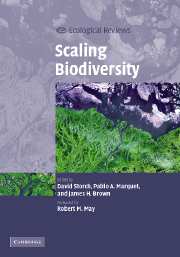Book contents
- Frontmatter
- Contents
- List of contributors
- Foreword by Robert M. May (Lord May of Oxford)
- Preface
- 1 Introduction: scaling biodiversity – what is the problem?
- PART I Spatial scaling of species richness and distribution
- PART II Alternative measures of biodiversity: taxonomy, phylogeny, and turnover
- PART III Scaling of biological diversity with energy and the latitudinal biodiversity gradient
- 11 Climate and diversity: the role of history
- 12 Inverse latitudinal gradients in species diversity
- 13 Regional-to-global patterns of biodiversity, and what they have to say about mechanisms
- 14 Recasting the species–energy hypothesis: the different roles of kinetic and potential energy in regulating biodiversity
- 15 Scaling species richness and distribution: uniting the species–area and species–energy relationships
- PART IV Processes, perspectives, and syntheses
- Index
- Plate section
- References
15 - Scaling species richness and distribution: uniting the species–area and species–energy relationships
Published online by Cambridge University Press: 05 August 2012
- Frontmatter
- Contents
- List of contributors
- Foreword by Robert M. May (Lord May of Oxford)
- Preface
- 1 Introduction: scaling biodiversity – what is the problem?
- PART I Spatial scaling of species richness and distribution
- PART II Alternative measures of biodiversity: taxonomy, phylogeny, and turnover
- PART III Scaling of biological diversity with energy and the latitudinal biodiversity gradient
- 11 Climate and diversity: the role of history
- 12 Inverse latitudinal gradients in species diversity
- 13 Regional-to-global patterns of biodiversity, and what they have to say about mechanisms
- 14 Recasting the species–energy hypothesis: the different roles of kinetic and potential energy in regulating biodiversity
- 15 Scaling species richness and distribution: uniting the species–area and species–energy relationships
- PART IV Processes, perspectives, and syntheses
- Index
- Plate section
- References
Summary
Introduction
Two macroecological patterns of species richness are sufficiently common and occur across such a wide range of taxa and geographic realms that they can be regarded as universal. The first is an increase in the number of species with the area sampled, the species–area relationship (hereafter SAR). The other is the relationship between species richness and the availability of energy that can be turned into biomass – the species–energy relationship (hereafter SER). Both patterns have a long history of exploration (e.g. Arrhenius, 1921; Gleason, 1922; Preston, 1960; Wright, 1983; Williamson, 1988; Currie, 1991; Rosenzweig, 1995; Waide et al., 1999; Gaston, 2000; Hawkins et al., 2003). However, attempts to interpret them within one unifying framework, or at least to relate them to each other, have been surprisingly rare. The most notable exception has been Wright's (1983) attempt to derive both patterns from the assumed relationship between total energy availability (defined as the product of available area and energy input per unit area) and population size. According to this theory, both area and energy positively affect species' population abundances, which decreases probabilities of population extinction, and thus increases the total number of species that can coexist on a site. Then, species richness should increase with increasing area or increasing energy in the same way.
Although this theory can be valid in island situations where the total number of species is determined by the rate of extinctions which are not balanced by immigration events (MacArthur & Wilson, 1967), the situation on the mainland is more complicated.
- Type
- Chapter
- Information
- Scaling Biodiversity , pp. 300 - 322Publisher: Cambridge University PressPrint publication year: 2007
References
- 7
- Cited by



